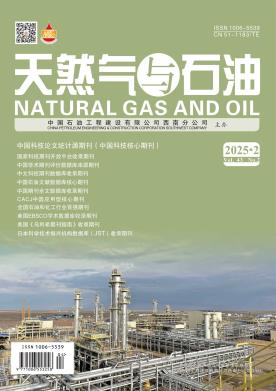【新能源相关】余压发电技术在天然气J-T阀脱水工艺中的应用
Application of residual pressure power generation technology in dehydration process of natural gas J-T valve
浏览(19247) 下载(73)
- 引用格式:
-
李尹建,刘刚,王建勤,蒲远洋,王海波,薛文奇,刘文广,林普,刘韬,杨育霖.【新能源相关】余压发电技术在天然气J-T阀脱水工艺中的应用[J].天然气与石油,2024,42(5):141-146.doi:10.3969/j.issn.1006-5539.2024.05.020
LI Yinjian, LIU Gang, WANG Jianqin, PU Yuanyang, WANG Haibo, XUE Wenqi, LIU Wenguang, LIN Pu, LIU Tao, YANG Yulin.Application of residual pressure power generation technology in dehydration process of natural gas J-T valve[J].Natural Gas and Oil,2024,42(5):141-146.doi:10.3969/j.issn.1006-5539.2024.05.020
- DOI:
- 10.3969/j.issn.1006-5539.2024.05.020
- 作者:
- 李尹建1 刘刚1 王建勤1 蒲远洋1 王海波1 薛文奇1 刘文广1 林普1 刘韬2 杨育霖3
LI Yinjian1, LIU Gang1, WANG Jianqin1, PU Yuanyang1, WANG Haibo1, XUE Wenqi1, LIU Wenguang1, LIN Pu1, LIU Tao2, YANG Yulin3
- 作者单位:
- 1. 中国石油工程建设有限公司西南分公司, 四川 成都 610041; 2. 中国石油西南油气田公司, 四川 成都 610051; 3. 中国石油西南油气田公司川中油气矿射洪采油气作业区, 四川 遂宁 629200
1. CPECC Southwest Company, Chengdu, Sichuan, 610041, China; 2. PetroChina Southwest Oil & Gasfield Company, Chengdu, Sichuan, 610051, China; 3. Shehong Oil and Gas Operation Zone in Central Sichuan, PetroChina Southwest Oil & Gasfield Company, Suining, Sichuan, 629200, China
- 关键词:
- 余压利用;J-T阀脱水工艺;新能源;高压含液天然气;发电
Utilization of residual pressure; J-T valve dehydration process; New energy; High pressure wet natural gas; Power generation
- 摘要:
天然气处理脱水工艺中利用焦耳—汤姆逊节流膨胀阀(以下简称J-T阀)降低天然气温度,以达到脱水工艺要求。脱水工艺过程中J-T阀前后有大量的压力能未被利用。由于J-T阀脱水工艺中天然气高压、含液,余压发电技术一直未能在J-T阀脱水工艺中应用。通过对某脱水脱烃装置现有工艺进行余压发电利用改造,提出相关优化措施,实现压力能的充分利用,达到节能、减排目的。余压发电技术对绿色能源利用的开拓具有参考意义。
In the natural gas dehydration process, the J-T expansion/throttling valve (hereinafter referred to as the J-T valve) is used to reduce the temperature of natural gas to meet the requirements of the dehydration process. In this process, there is a huge amount of unutilised pressure energy before and after the J-T valve. However, due to the presence of liquid in the high-pressure natural gas in the J-T valve dehydration process, the power generation technology using natural gas residual pressure has not been applied in the J-T valve dehydration process before. This article analyzes the process conversion to residual pressure power generation in the expansion project of the existing system for water and hydrocarbon dew point control. Relevant optimization measures are proposed to achieve energy conservation and emission reduction via the optimal utilization of pressure energy. This technology provides reference for the expansion of green energy utilization.



